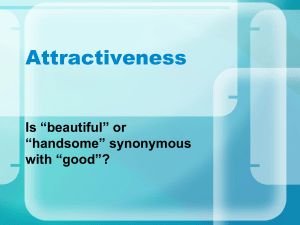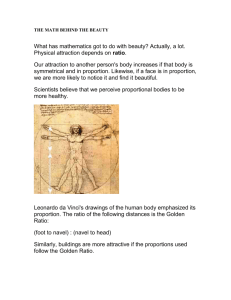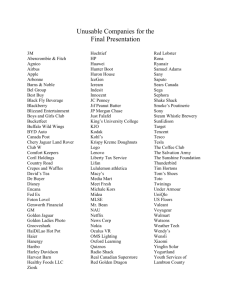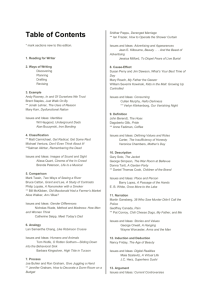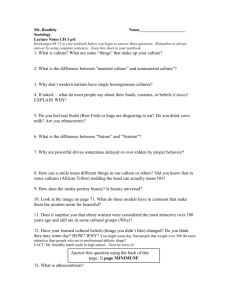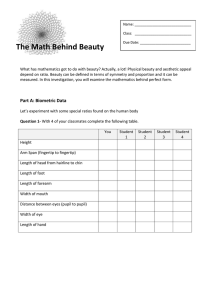The Biology of Beauty: Golden Ratio & Attractiveness
advertisement
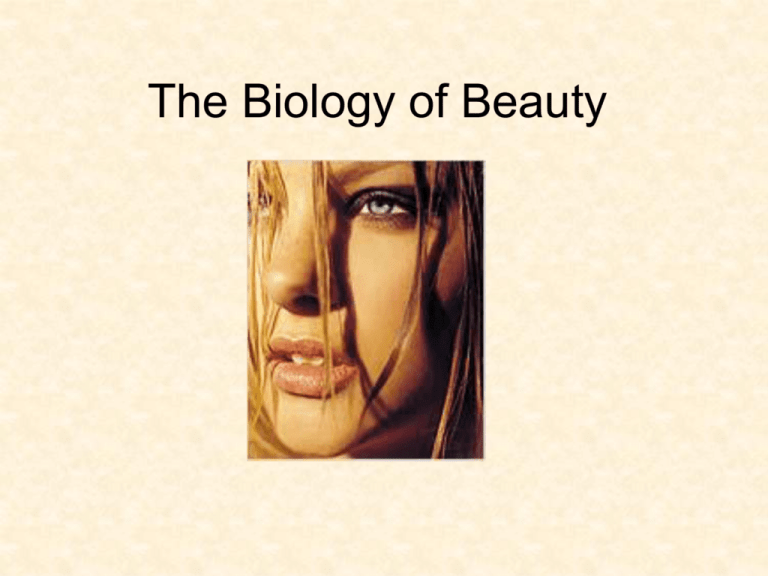
The Biology of Beauty "Throughout the animal world attractiveness certifies biological quality." • There's no reason to think that any of these creatures understands its motivations, but there's a clear pattern to their preferences. Beauty is Timeless • It's widely assumed that ideals of beauty vary from era to era and from culture to culture. But a harvest of new research is confounding that idea. • Studies have established that people everywhere--regardless of race, class or age--share a sense of what's attractive. • And though no one knows just how our minds translate the sight of a face or a body into rapture, new studies suggest that we judge each other by rules we're not even aware of. We may consciously admire Kate Moss's legs or Arnold's biceps, but we're also viscerally attuned to small variations in the size and symmetry of facial bones and the placement of weight on the body. Golden Ratio • In an attempt to answer this question, the philosophers of the day devoted a great deal of time to this conundrum. Plato wrote of so-called "golden proportions," in which, amongst other things, the width of an ideal face would be two-thirds its length, while a nose would be no longer than the distance between the eyes. The origins of the divine proportion • In the Elements, the most influential mathematics textbook ever written, Euclid of Alexandria (ca. 300 BC) defines a proportion derived from a division of a line into what he calls its "extreme and mean ratio." Euclid's definition reads: • A straight line is said to have been cut in extreme and mean ratio when, as the whole line is to the greater segment, so is the greater to the lesser. • In other words, in the diagram above, point C divides the line in such a way that the ratio of AC to CB is equal to the ratio of AB to AC. Some elementary algebra shows that in this case the ratio of AC to CB is equal to the irrational number 1.618 (precisely half the sum of 1 and the square root of 5). • C divides the line segment AB according to the Golden Ratio • Who could have guessed that this innocent-looking line division would have implications for numerous natural phenomena ranging from the leaf and seed arrangements of plants to the structure of the crystals of some aluminium alloys, and from the arts to the stock market? Sunflower seeds • In fact, with the increasing realization of the astonishing properties of this number over the centuries since Euclid's definition, the number was given the honorifics "Divine Proportion" and "Golden Ratio." The golden ratio in the arts • Many books claim that if you draw a rectangle around the face of Leonardo da Vinci's Mona Lisa, the ratio of the height to width of that rectangle is equal to the Golden Ratio. No documentation exists to indicate that Leonardo consciously used the Golden Ratio in the Mona Lisa's composition, nor to where precisely the rectangle should be drawn. • Standards of beauty may be related to natural mathematical proportions which have captivated humans across cultures since the beginning of time, such as the golden ratio (approximately 1.618:1). Some beautiful faces do seem to exhibit such geometric proportions. • Science writer Eric Haseltine claimed (in an article in Discover magazine in September 2002) to have found that the distance from the chin to the eyebrows in Langlois's 32-composite faces divides the face in a Golden Ratio. A similar claim was made in 1994 by orthodontist Mark Lowey, then at University College Hospital in London. Lowey made detailed measurements of fashion models' faces. He asserted that the reason we classify certain people as beautiful is because they come closer to Golden Ratio proportions in the face than the rest of the population. Cross-cultural Attractiveness Ratings (Langlois 1990, 1994, 2000) • Participants were gathered from various countries, ethnicities and racial groups to rate the physical attractiveness of photographs of equally diverse people. Surprisingly, the perception of beauty is uniform across cultures. To support the hypothesis that there is an evolutionary basis for attraction, infants across cultures were also tested, and they prefer the same photographs that adults prefer. • Newborn babies come fully equipped with built-in preferences, including a preference for an attractive face, that help them make sense of their new environment, • Researchers showed more than 100 infants two images that were placed side by side. • One was of an attractive face, while the other was a less attractive face. The babies, ranging in age from five hours old to two days old, spent about 80 percent of the time looking at the attractive face, while barely glancing at the unattractive face. • "You can show them pair after pair of faces that are matched for everything other than attractiveness. This leads to the conclusion that babies are born with a very detailed representation of the human face," • Dr. Alan Slater, a psychologist at Exeter, explained to the BBC News. • Attractiveness is not simply in the eye of the beholder, it is in the brain of the newborn infant right from the moment of birth and possibly prior to birth," he added. • When those babies grow up, the preference for pretty faces doesn't change. And it crosses all cultures and geography as well. When an insular European is shown the faces of two Africans, the one he chooses as most attractive is also the same one an African chooses. And it works the other way around when an African is shown the faces of two Europeans. • "Although we think that standards of facial beauty vary over time and culture, they don't actually change that much," Slater explained to Newsweek. The evidence indicates that there is a biological and universal standard." So don't blame a man when he can't help but look at a pretty face! He's biologically programmed that way. • http://www.crystalinks.com/sacred_geometry.html • http://www.gi.alaska.edu/ScienceForum/ASF7/716.ht ml • http://www.markwahl.com/golden-ratio.htm • http://www.english.uiuc.edu/maps/poets/g_l/hd/abouthele n.htm • Newsweek, June 3, 1996 v127 n23 p60(7) The biology of beauty. (Cover Story) Geoffrey Cowley. • http://channels.netscape.com/men/package.jsp?name=ft e/prettyfaces/prettyfaces&floc=wn-ns • Page 46 -47 N Alchin “Theory of Knowledge” • Is ‘beauty’ just ‘biology’?

